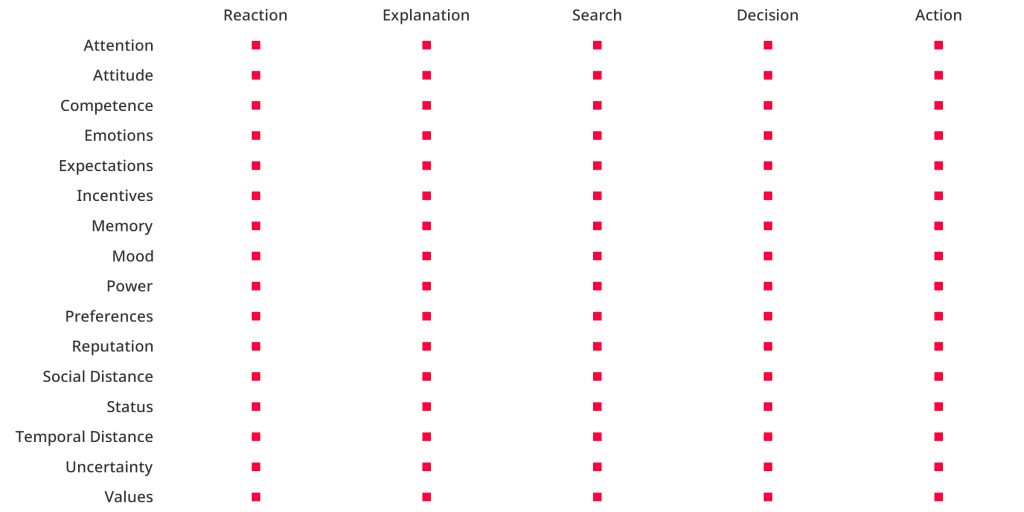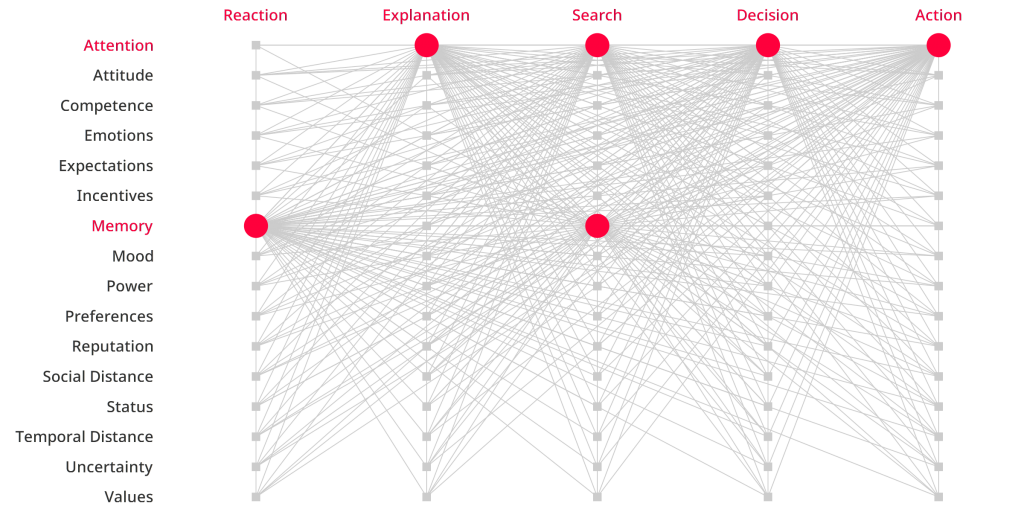What are the parameters of a decision situation that we want to influence through decision governance? This text presents these parameters and organizes them in a framework that can be used to describe and compare decision governance guidelines, and design decision governance. The framework is specific to decision situations in which only one person has the right to make the decision.
This text is part of the series on decision governance. Decision Governance is concerned with how to improve the quality of decisions by changing the context, process, data, and tools (including AI) used to make decisions. Understanding decision governance empowers decision makers and decision stakeholders to improve how they make decisions with others. Start with “What is Decision Governance?” and find all texts on decision governance here.
There are two groups of parameters:
- Decision Process Parameters: Parameters that determine the decision process, that is, delimit the main types of activities that the decision maker does, between the time they see the need for a decision, to after they have decided, take actions that they chose, and are observing the outcomes of the actions.
- Decision Information Parameters: Parameters which determine which information the decision maker uses, and how they use that information during the decision process.
Decision Process Parameters are the following:
- Reaction: The stage when the decision maker has observed something that leads them to believe that they need to take action, even if they may not know which action or how.
- Explanation: The stage during which the decision maker is building an explanation of what happened, why it happened, and why this led them to need to take action.
- Search: The stage when the decision maker is identifying options, or developing one option.
- Decision: The decision maker commits to an option, that is, to perform specific actions.
- Action: The stage during which the decision maker is performing the actions they committed to perform.
Actions lead to outcomes which are observed by the decision maker and constitute part of their reaction – that is, as actions are taken, we are in a new Reaction stage as we start observing outcomes.
Stages above are not necessarily clear cut, and they do not need to be. There are various decision processes, across different decision makers and decision situations they are in. I am not arguing that any decision process has these stages, but instead, that many will, and so it is useful to consider whether and how the decision process you are designing or need to govern, relates to these common stages. If you are designing a decision process as part of decision governance you need to put in place, it is useful to start from these stages and adapt them as needed.
Decision Information Parameters are listed and defined below, with a common reference where they are discussed in the context of research on decision making.
- Attention: The mental process of selectively concentrating on certain stimuli while ignoring others, guiding the decision-maker’s focus and potentially shaping outcomes based on what information is prioritized (Kahneman, 1973).
- Memory: The cognitive system for encoding, storing, and retrieving information, which impacts decision-making by affecting how past experiences inform current judgments and choices (Baddeley, 2000).
- Emotion: A complex psychological state involving subjective experience, physiological response, and behavioral expression that influences decision-making through motivation, risk perception, and value assessment (Lerner & Keltner, 2000).
- Attitude: A psychological tendency expressed by evaluating an entity with some degree of favor or disfavor, which affects how individuals process information and form decisions (Ajzen, 1991).
- Mood: A temporary affective state that, unlike emotion, is less intense and not necessarily directed at a specific object, but can influence the cognitive processes in decision-making by altering judgment and perception (Forgas, 1995).
- Values: Core beliefs or standards that guide individual behavior and decision-making, shaping what is considered desirable, acceptable, and worthy of pursuit (Schwartz, 1992).
- Preferences: An individual’s evaluative judgments about choices or outcomes, often described as subjective utilities that drive decisions based on perceived benefit or satisfaction (Kahneman & Tversky, 1979).
- Status: A social position or rank within a hierarchy that can influence decision-making through perceived power dynamics, role expectations, and resource access (Anderson et al., 2001).
- Power: The capacity to influence others and control resources, impacting decision processes by shaping authority, accountability, and risk tolerance (Fiske, 1993).
- Temporal Distance: The perceived time between the present and a future event, influencing decision-making by affecting how individuals value future versus immediate rewards (Trope & Liberman, 2003).
- Social Distance: The perceived level of closeness or remoteness to others, which can affect decisions related to empathy, fairness, and cooperation (Liberman & Trope, 2008).
- Competence: The perception of one’s own or others’ ability to perform tasks effectively, which can affect confidence, trust, and reliance in decision-making (Heath & Tversky, 1991).
- Expectations: Beliefs about the likelihood of future events, influencing decision-making through perceived risks and anticipated outcomes (Mischel & Shoda, 1995).
- Reputation: The collective assessment of an individual’s or organization’s past behavior, impacting decision-making through trust, credibility, and perceived reliability (Raub & Weesie, 1990).
- Incentives: External motivators designed to influence behavior, typically structured as rewards or penalties that guide decision choices (Vroom, 1964).
- Uncertainty: The condition of limited knowledge about possible outcomes or probabilities, affecting decision-making by increasing perceived risk and reliance on heuristics (Knight, 1921).
The two dimensions are combined in the image below to show the variety of design decisions that we need to consider – for example, how do guidelines, rules, processes we design influence Attention at the Reaction stage? What is the value if they do? What are their dependencies? The aim is not to show that the design of decision governance is a complex problem – it can certainly be – but that it is also not simply a problem of designing a decision process as it seems to be in, e.g., classical decision analysis. The design space for decision governance is much richer, and much more interesting.

The same visualization of the design space is used in other texts about decision governance parameters. The visualization shows the variety of dependencies relative to the parameters we are influencing through governance. For example, the visualization below shows the multitude of dependencies when we are targeting Attention across the Explanation, Search, Decision, and Action stages, and Memory in the Reaction and Search stages.

This visualization also shows highlights that when we govern specific parameters, we cannot isolate them from all others. Influencing memory can influence, for example, perception of reputation, status, in ways which may not be evident – it does not only regulate memory, or only regulate attention. The visualization exaggerates this, of course, as not all relationships will be strong enough to matter; nevertheless, awareness of dependencies helps decide what to govern, and how.
References and Further Reading
- Kahneman, D. (1973). Attention and Effort. Englewood Cliffs, NJ: Prentice-Hall.
- Baddeley, A. (2000). The episodic buffer: A new component of working memory? Trends in Cognitive Sciences, 4(11), 417–423.
- Lerner, J. S., & Keltner, D. (2000). Beyond valence: Toward a model of emotion-specific influences on judgement and choice. Cognition and Emotion, 14(4), 473–493.
- Ajzen, I. (1991). The theory of planned behavior. Organizational Behavior and Human Decision Processes, 50(2), 179–211.
- Forgas, J. P. (1995). Mood and judgment: The affect infusion model (AIM). Psychological Bulletin, 117(1), 39–66.
- Schwartz, S. H. (1992). Universals in the content and structure of values: Theoretical advances and empirical tests in 20 countries. In Advances in Experimental Social Psychology (Vol. 25, pp. 1–65). Academic Press.
- Kahneman, D., & Tversky, A. (1979). Prospect theory: An analysis of decision under risk. Econometrica, 47(2), 263–291.
- Anderson, C., John, O. P., Keltner, D., & Kring, A. M. (2001). Who attains social status? Effects of personality and physical attractiveness in social groups. Journal of Personality and Social Psychology, 81(1), 116–132.
- Fiske, S. T. (1993). Controlling other people: The impact of power on stereotyping. American Psychologist, 48(6), 621–628.
- Trope, Y., & Liberman, N. (2003). Temporal construal. Psychological Review, 110(3), 403–421.
- Liberman, N., & Trope, Y. (2008). The psychology of transcending the here and now. Science, 322(5905), 1201–1205.
- Heath, C., & Tversky, A. (1991). Preference and belief: Ambiguity and competence in choice under uncertainty. Journal of Risk and Uncertainty, 4(1), 5–28.
- Mischel, W., & Shoda, Y. (1995). A cognitive-affective system theory of personality: Reconceptualizing situations, dispositions, dynamics, and invariance in personality structure. Psychological Review, 102(2), 246–268.
- Raub, W., & Weesie, J. (1990). Reputation and efficiency in social interactions: An example of network effects. American Journal of Sociology, 96(3), 626–654.
- Vroom, V. H. (1964). Work and Motivation. New York: Wiley.
- Knight, F. H. (1921). Risk, Uncertainty, and Profit. Boston, MA: Houghton Mifflin.
Decision Governance
This text is part of the series on the design of decision governance. Other texts on the same topic are linked below. This list expands as I add more texts on decision governance.
- Introduction to Decision Governance
- Stakeholders of Decision Governance
- Foundations of Decision Governance
- How to Spot Decisions in the Wild?
- When Is It Useful to Reify Decisions?
- Decision Governance Is Interdisciplinary
- Individual Decision-Making: Common Models in Economics
- Group Decision-Making: Common Models in Economics
- Individual Decision-Making: Common Models in Psychology
- Group Decision-Making: Common Models in Organizational Theory
- Role of Explanations in the Design of Decision Governance
- Design of Decision Governance
- Design Parameters of Decision Governance
- Factors influencing how an individual selects and processes information in a decision situation, including which information the individual seeks and selects to use:
- Psychological factors, which are determined by the individual, including their reaction to other factors:
- Attention:
- Memory:
- Mood:
- Emotions:
- Commitment:
- Temporal Distance:
- Social Distance:
- Expectations
- Uncertainty
- Attitude:
- Values:
- Goals:
- Preferences:
- Competence
- Social factors, which are determined by relationships with others:
- Impressions of Others:
- Reputation:
- Promises:
- Social Hierarchies:
- Social Hierarchies: Why They Matter for Decision Governance
- Social Hierarchies: Benefits and Limitations in Decision Processes
- Social Hierarchies: How They Form and Change
- Power: Influence on Decision Making and Its Risks
- Power: Relationship to Psychological Factors in Decision Making
- Power: Sources of Legitimacy and Implications for Decision Authority
- Power: Stability and Destabilization of Legitimacy
- Power: What If High Decision Authority Is Combined With Low Power
- Power: How Can Low Power Decision Makers Be Credible?
- Social Learning:
- Psychological factors, which are determined by the individual, including their reaction to other factors:
- Factors influencing information the individual can gain access to in a decision situation, and the perception of possible actions the individual can take, and how they can perform these actions:
- Governance factors, which are rules applicable in the given decision situation:
- Incentives:
- Incentives: Components of Incentive Mechanisms
- Incentives: Example of a Common Incentive Mechanism
- Incentives: Building Out An Incentive Mechanism From Scratch
- Incentives: Negative Consequences of Incentive Mechanisms
- Crowding-Out Effect: The Wrong Incentives Erode the Right Motives
- Crowding-In Effect: The Right Incentives Amplify the Right Motives
- Rules
- Rules-in-use
- Rules-in-form
- Institutions
- Incentives:
- Technological factors, or tools which influence how information is represented and accessed, among others, and how communication can be done
- Environmental factors, or the physical environment, humans and other organisms that the individual must and can interact with
- Governance factors, which are rules applicable in the given decision situation:
- Factors influencing how an individual selects and processes information in a decision situation, including which information the individual seeks and selects to use:
- Change of Decision Governance
- Public Policy and Decision Governance:
- Compliance to Policies:
- Transformation of Decision Governance
- Mechanisms for the Change of Decision Governance